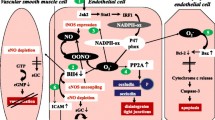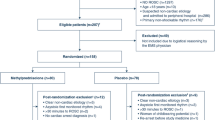Abstract
Inflammation is responsible for secondary organ failure after trauma and hemorrhagic shock (T/HS). Adenosine, acting through four G protein-coupled cell surface receptors, A1, A2A, A2B, and A3, exerts a number of tissue protective and anti-inflammatory effects. The goal of the present study was to test the effect of A2B adenosine receptor stimulation on T/HS-induced organ injury and inflammation in rats. Rats after T/HS were resuscitated with Ringer’s lactate containing the A2B receptor agonist BAY 60–6583 or its vehicle. We found that BAY 60–6583 decreased T/HS-induced lung permeability and plasma creatine kinase levels but failed to affect T/HS-induced lung neutrophil infiltration and IκBα expression and plasma alanine aminotransferase levels. Thus, we conclude that stimulation of A2B receptors protects against T/HS-induced lung and muscle injury.



Similar content being viewed by others
References
Hierholzer C, Billiar TR (2001) Molecular mechanisms in the early phase of hemorrhagic shock. Langenbecks Arch Surg 386(4):302–308
Deitch EA (1992) Multiple organ failure. Pathophysiology and potential future therapy. Ann Surg 216(2):117–134
Bours MJL, Swennen ELR, Di Virgilio F, Cronstein BN, Dagnelie PC (2006) Adenosine 5′-triphosphate and adenosine as endogenous signaling molecules in immunity and inflammation. Pharmacol Ther 112(2):358–404
Hasko G, Deitch EA, Szabo C, Nemeth ZH, Vizi ES (2002) Adenosine: a potential mediator of immunosuppression in multiple organ failure. Curr Opin Pharmacol 2(4):440–444
Hasko G, Cronstein BN (2004) Adenosine: an endogenous regulator of innate immunity. Trends Immunol 25(1):33–39
Cronstein BN, Kramer SB, Weissmann G, Hirschhorn R (1983) Adenosine: a physiological modulator of superoxide anion generation by human neutrophils. J Exp Med 158(4):1160–1177
Fredholm BB, IJzerman AP, Jacobson KA, Klotz KN, Linden J (2001) International Union of Pharmacology. XXV. Nomenclature and classification of adenosine receptors. Pharmacol Rev 53(4):527–552
Hasko G, Linden J, Cronstein B, Pacher P (2008) Adenosine receptors: therapeutic aspects for inflammatory and immune diseases. Nat Rev Drug Discov 7(9):759–770. doi:10.1038/nrd2638
Hasko G, Pacher P, Deitch EA, Vizi ES (2007) Shaping of monocyte and macrophage function by adenosine receptors. Pharmacol Ther 113(2):264–275. doi:10.1016/j.pharmthera.2006.08.003
Hasko G, Pacher P (2012) Regulation of macrophage function by adenosine. Arterioscler Thromb Vasc Biol 32(4):865–869. doi:10.1161/ATVBAHA.111.226852
Hasko G, Xu DZ, Lu Q, Nemeth ZH, Jabush J, Berezina TL, Zaets SB, Csoka B, Deitch EA (2006) Adenosine A2A receptor activation reduces lung injury in trauma/hemorrhagic shock. Crit Care Med 34(4):1119–1125. doi:10.1097/01.CCM.0000206467.19509.C6
Eckle T, Krahn T, Grenz A, Kohler D, Mittelbronn M, Ledent C, Jacobson MA, Osswald H, Thompson LF, Unertl K, Eltzschig HK (2007) Cardioprotection by ecto-5′-nucleotidase (CD73) and A2B adenosine receptors. Circulation 115(12):1581–1590. doi:10.1161/CIRCULATIONAHA.106.669697
Hart ML, Jacobi B, Schittenhelm J, Henn M, Eltzschig HK (2009) Cutting edge: A2B adenosine receptor signaling provides potent protection during intestinal ischemia/reperfusion injury. J Immunol 182(7):3965–3968. doi:10.4049/jimmunol.0802193
Schingnitz U, Hartmann K, Macmanus CF, Eckle T, Zug S, Colgan SP, Eltzschig HK (2010) Signaling through the A2B adenosine receptor dampens endotoxin-induced acute lung injury. J Immunol 184(9):5271–5279. doi:10.4049/jimmunol.0903035
Eckle T, Faigle M, Grenz A, Laucher S, Thompson LF, Eltzschig HK (2008) A2B adenosine receptor dampens hypoxia-induced vascular leak. Blood 111(4):2024–2035. doi:10.1182/blood-2007-10-117044
Rosenberger P, Schwab JM, Mirakaj V, Masekowsky E, Mager A, Morote-Garcia JC, Unertl K, Eltzschig HK (2009) Hypoxia-inducible factor-dependent induction of netrin-1 dampens inflammation caused by hypoxia. Nat Immunol 10(2):195–202. doi:10.1038/ni.1683
Yang D, Zhang Y, Nguyen HG, Koupenova M, Chauhan AK, Makitalo M, Jones MR, St Hilaire C, Seldin DC, Toselli P, Lamperti E, Schreiber BM, Gavras H, Wagner DD, Ravid K (2006) The A2B adenosine receptor protects against inflammation and excessive vascular adhesion. J Clin Invest 116(7):1913–1923. doi:10.1172/JCI27933
Eckle T, Grenz A, Laucher S, Eltzschig HK (2008) A2B adenosine receptor signaling attenuates acute lung injury by enhancing alveolar fluid clearance in mice. J Clin Invest 118(10):3301–3315. doi:10.1172/JCI34203
Lehnert M, Relja B, Sun-Young Lee V, Schwestka B, Henrich D, Czerny C, Froh M, Borsello T, Marzi I (2008) A peptide inhibitor of C-jun N-terminal kinase modulates hepatic damage and the inflammatory response after hemorrhagic shock and resuscitation. Shock 30(2):159–165. doi:10.1097/SHK.0b013e31815dd623
Sato H, Tanaka T, Kasai K, Kita T, Tanaka N (2007) Role of p38 mitogen-activated protein kinase on cardiac dysfunction after hemorrhagic shock in rats. Shock 28(3):291–299. doi:10.1097/SHK.0b013e3180326e3d
Korff S, Falsafi R, Czerny C, Jobin C, Nau C, Jakob H, Marzi I, Lehnert M (2012) Time dependency and topography of hepatic nuclear factor kappaB activation after hemorrhagic shock and resuscitation in mice. Shock 38(5):486–492. doi:10.1097/SHK.0b013e3182699072
Kalk P, Eggert B, Relle K, Godes M, Heiden S, Sharkovska Y, Fischer Y, Ziegler D, Bielenberg GW, Hocher B (2007) The adenosine A1 receptor antagonist SLV320 reduces myocardial fibrosis in rats with 5/6 nephrectomy without affecting blood pressure. Br J Pharmacol 151(7):1025–1032. doi:10.1038/sj.bjp.0707319
Eckle T, Hartmann K, Bonney S, Reithel S, Mittelbronn M, Walker LA, Lowes BD, Han J, Borchers CH, Buttrick PM, Kominsky DJ, Colgan SP, Eltzschig HK (2012) Adora2b-elicited Per2 stabilization promotes a HIF-dependent metabolic switch crucial for myocardial adaptation to ischemia. Nat Med 18(5):774–782. doi:10.1038/nm.2728
Thourani VH, Ronson RS, Jordan JE, Guyton RA, Vinten-Johansen J (1999) Adenosine A3 pretreatment before cardioplegic arrest attenuates postischemic cardiac dysfunction. Ann Thorac Surg 67(6):1732–1737
Thourani VH, Nakamura M, Ronson RS, Jordan JE, Zhao ZQ, Levy JH, Szlam F, Guyton RA, Vinten-Johansen J (1999) Adenosine A(3)-receptor stimulation attenuates postischemic dysfunction through K(ATP) channels. Am J Physiol 277(1 Pt 2):H228–H235
Hasko G, Szabo C, Nemeth ZH, Kvetan V, Pastores SM, Vizi ES (1996) Adenosine receptor agonists differentially regulate IL-10, TNF-alpha, and nitric oxide production in RAW 264.7 macrophages and in endotoxemic mice. J Immunol 157(10):4634–4640
Hasko G, Kuhel DG, Chen JF, Schwarzschild MA, Deitch EA, Mabley JG, Marton A, Szabo C (2000) Adenosine inhibits IL-12 and TNF-[alpha] production via adenosine A2a receptor-dependent and independent mechanisms. FASEB J 14(13):2065–2074. doi:10.1096/fj.99-0508com
Csoka B, Nemeth ZH, Virag L, Gergely P, Leibovich SJ, Pacher P, Sun CX, Blackburn MR, Vizi ES, Deitch EA, Hasko G (2007) A2A adenosine receptors and C/EBPbeta are crucially required for IL-10 production by macrophages exposed to Escherichia coli. Blood 110(7):2685–2695. doi:10.1182/blood-2007-01-065870
Kobbe P, Schmidt J, Stoffels B, Chanthaphavong RS, Bauer AJ, Pape HC (2009) IL-10 administration attenuates pulmonary neutrophil infiltration and alters pulmonary iNOS activation following hemorrhagic shock. Inflamm Res Off J Eur Hist Res Soc 58(3):170–174. doi:10.1007/s00011-009-8116-z
Kobbe P, Stoffels B, Schmidt J, Tsukamoto T, Gutkin DW, Bauer AJ, Pape HC (2009) IL-10 deficiency augments acute lung but not liver injury in hemorrhagic shock. Cytokine 45(1):26–31. doi:10.1016/j.cyto.2008.10.004
Acknowledgments
This work was supported by National Institutes of Health grants R01GM066189; USAMRMC grant log# 09065004 (contract W81XWH-10-1-1015); Hungarian Scientific Research Fund (OTKA) grant CK 78275 to GH; National Heart Institute Grants R01-HL0921, R01-DK083385, and R01-HL098294; and a grant by the Crohn’s and Colitis Foundation of America to HKE.
Author information
Authors and Affiliations
Corresponding author
Additional information
Balázs Koscsó and Alexey Trepakov contributed equally to this work.
Rights and permissions
About this article
Cite this article
Koscsó, B., Trepakov, A., Csóka, B. et al. Stimulation of A2B adenosine receptors protects against trauma–hemorrhagic shock-induced lung injury. Purinergic Signalling 9, 427–432 (2013). https://doi.org/10.1007/s11302-013-9362-7
Received:
Accepted:
Published:
Issue Date:
DOI: https://doi.org/10.1007/s11302-013-9362-7




